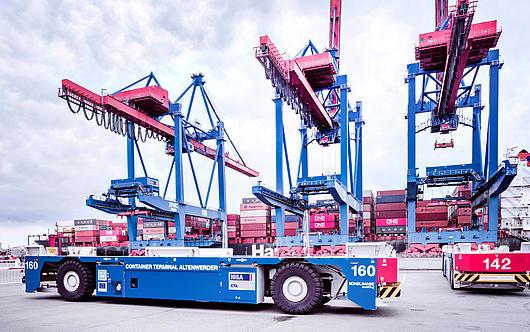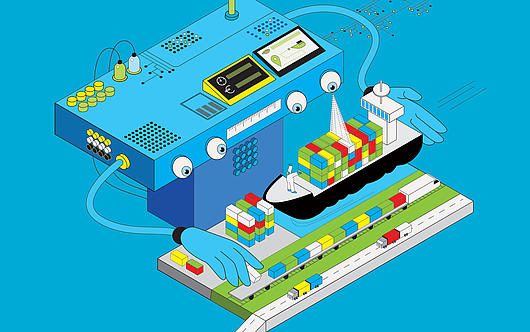
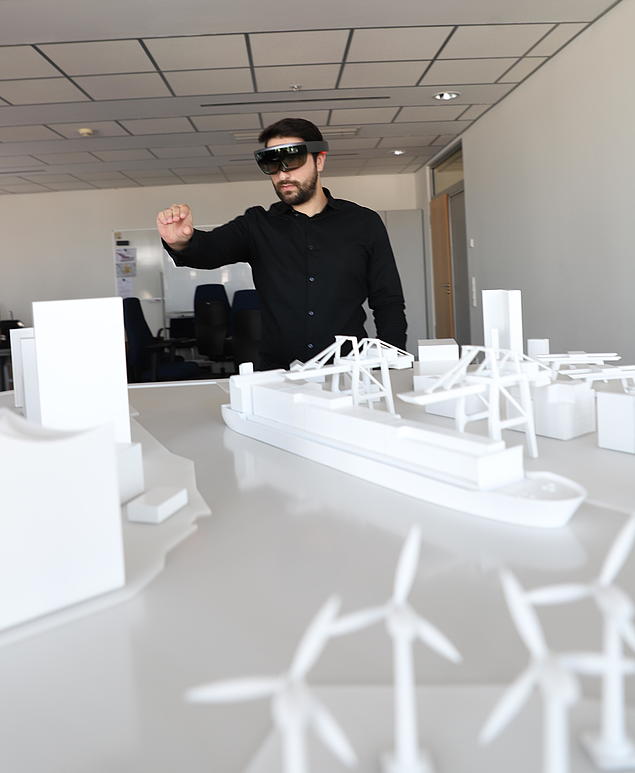
Hasibullah Mirzada has set his sights on the future
Using a pair of smartglasses, HHLA Sky’s service manager controls the flight operations of three drones in the airspace above the Port of Hamburg. The glasses make virtual reality visible, and they project speed and altitude details over the real-life city model in front of his eyes. When a superimposed red bar before his eyes warns him not to enter a no-fly zone over the Elbe Philharmonic Hall, he instantly changes the drone’s flight direction and altitude with a move of his hand.
Mirzada is still testing experimental drone control with the help of augmented reality on a model of the port in the HHLA administrative building at Terminal Tollerort. Beside him, his colleague Thorsten Indra is already using the latest version of this forward-looking technology in practice. On a large screen and several 27-inch monitors, he tracks how the drones automatically inspect the port or industrial customers’ premises.
Globally unique control system
Mirzada and Indra are part of the team of developers at corporate start-up HHLA Sky, a subsidiary of Hamburger Hafen und Logistik AG (HHLA). In addition to designing a robust professional drone, the company has developed the software for a globally unique control centre for drone operation. This system enables Indra to monitor more than 100 auto-piloted drones – even if they’re beyond his visual line of sight and hundreds of kilometres away – and to intervene immediately if they deviate from their programmed flight plan. “We are revolutionising the fast-growing world of remote-controlled aircraft for industrial use,” says Mirzada confidently, as he takes off his glasses.
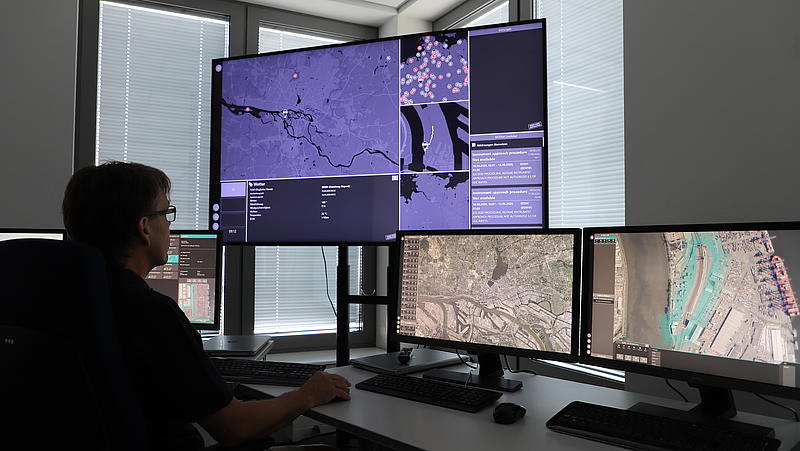
At first, there wouldn’t seem to be a connection between a port operator and logistics company and drone technology development. It is of course conceivable that the quickest way of transporting replacement parts and tools over the vast port area to the job site would be by air. “But drones can do much more,” Matthias Gronstedt, who manages HHLA Sky’s activities, explains confidently. “They can be used for monitoring and inspection, to track processes and to deliver a wide range of information via cameras and sensors.”
Experience since 2017
HHLA has used drones since 2017: to gather information about activities at the 7,200-hectare port and on the current condition of infrastructure; to inspect cranes, container gantry cranes and facilities; and to optimise logistical processes. “This experience was a good foundation for HHLA Sky and our developments,” says Gronstedt.
The idea for HHLA Sky is part of the digitalisation strategy that the Chairwoman of HHLA’s Executive Board, Angela Titzrath, is pursuing for the port company. “We are using our own activities, skill and experience to create new technologies and develop them into forward-looking business areas,” is how she defines her objective.
The drone concept fits in with these considerations: HHLA is extremely familiar with complex control processes such as those involving the use of automated transport vehicles at Container Terminal Altenwerder. Remote sensing has long been an important topic because of Altenwerder’s vast water and terminal spaces. Digitalisation is indispensable at the port for coordinating ship arrivals and departures, and for logistics processes after loading and unloading.
Shortly after Hasibullah completes his virtual flight to the “Elphi” philharmonic hall, another HHLA Sky drone takes off at the periphery of the Port of Hamburg to conduct a real mission. Operations manager and drone pilot Sven Howar monitors the six-propeller aircraft using a tablet. The integrated camera will check the security fence at the boundary of HHLA Container Terminal Altenwerder (CTA).
The drone moves barely a metre above the barbed wire fence and just a few metres from the containers. The aircraft’s path is programmed – one of the strengths of the system. Having a pilot on-site would be completely unnecessary. “The control centre has the same functionalities that I have here on my tablet,” explains Howar.
Sensors in the drone and underneath the camera deliver all the data needed to control the aircraft’s behaviour and position. “We can programme the specific tasks and the flight route. If there are any deviations, the operator at the control centre receives a signal and can intervene immediately in real time,” says Howar.
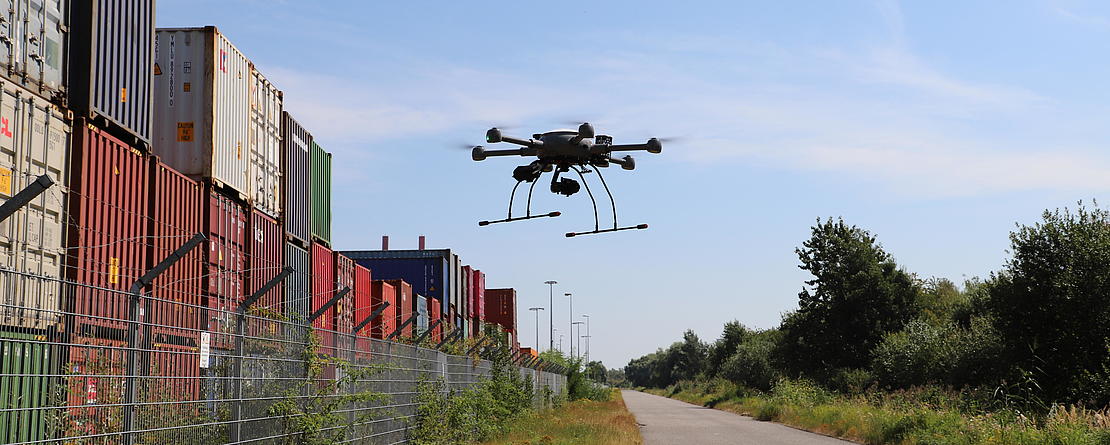
Highly professional aircraft
This system apparently also functions under more extreme conditions: Howar and his colleague Matthias Schreiber have conducted similar flights to inspect the container gantry cranes, which are up to 130 metres high. Previously, an entire team of industrial climbers was needed.
The inspection flights of the container gantry cranes and the extensive test rounds beyond the port all underscore the capability of the drones and their control systems. “We’re not talking about hobby applications here; these are highly professional aircraft,” stresses Gronstedt.
The drones check their own operating condition before they take off. Throughout the flight, the device also monitors its exact position, observes its surroundings and identifies unexpected obstructions. It transmits current data to the control centre in near real-time via the LTE mobile phone network.
Thorsten Indra can see all the airborne drones on a large screen. With one click, he can display the details of the flight operation and the current data. If the aircraft registers a deviation, it triggers an alarm at the control centre.
Should the network shut down and prevent the data from being transmitted to the control centre, the drone will initially continue flying as per the pre-programmed plan before performing a self-controlled landing.
The drone is even equipped to deal with a complete loss of power: In this event, the aircraft, which weighs eleven kilogrammes, will descend to the ground at three metres per second, using a parachute that deploys automatically.
HHLA Sky’s business model envisages operating drones on behalf of customers as well as selling or renting the complete system. It’s a large market, and the first customers have already signed contracts with HHLA Sky.
For example, drones could inspect facilities in the gas, oil and chemical industry. Another option would be to deploy them to optimise internal transport chains: The aircraft can transport small parts weighing up to three kilos; perform quick warehouse inspections; and take special measurements using sensors for spectral analysis, for example. The HHLA Sky experts also help customers to realign their processes with the new technical possibilities.
The drones’ fascinating versatility has also got the attention of the Hamburg police. As soon as the HHLA drone lands back on the ground beside the port fence, a police car pulls up to the landing site. The officers have seen the drone from afar. But their concern about the legality of the activities quickly takes a back seat: They’re more interested in the technology, and how the drones are controlled. And they might just trade in their patrol car for a drone some day.
Last update 28 June 2021
